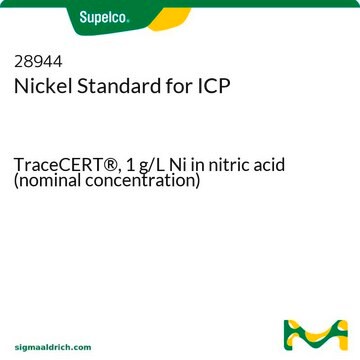01969
Arsenic Standard for ICP
TraceCERT®, 1 g/L As in nitric acid (nominal concentration)
About This Item
Prodotti consigliati
Grado
certified reference material
TraceCERT®
Livello qualitativo
Nome Commerciale
TraceCERT®
Concentrazione
1 g/L As in nitric acid (nominal concentration)
tecniche
ICP: suitable
applicazioni
agriculture
cleaning products
cosmetics
food and beverages
personal care
Formato
single component solution
Descrizione generale
Please visit ISO certificates and Site Quality Self-Assessments to access the current certificates of accreditation.
Download your certificate at http://www.sigma-aldrich.com to view certified values, including uncertainty, date of expiry, and detailed information about trace impurities.
Applicazioni
Risultati analitici
Altre note
Note legali
Avvertenze
Danger
Indicazioni di pericolo
Consigli di prudenza
Classi di pericolo
Carc. 1A - Eye Dam. 1 - Met. Corr. 1 - Skin Irrit. 2
Codice della classe di stoccaggio
6.1D - Non-combustible acute toxic Cat.3 / toxic hazardous materials or hazardous materials causing chronic effects
Classe di pericolosità dell'acqua (WGK)
WGK 3
Punto d’infiammabilità (°F)
Not applicable
Punto d’infiammabilità (°C)
Not applicable
Dispositivi di protezione individuale
Faceshields, Gloves, Goggles, type ABEK (EN14387) respirator filter
Elenchi normativi
Forniamo informazioni su eventuali restrizioni prevalentemente per i prodotti chimici. Per altre tipologie di prodotto siamo in grado di fornire soltanto informazioni limitate. Nessuna segnalazione significa che nessuno dei componenti è citato in un elenco. È dovere dell’utilizzatore assicurarsi che il prodotto venga impiegato in maniera sicura e a norme di legge.
EU REACH SVHC Candidate List
EU REACH Annex XVII (Restriction List)
EU REACH Annex XIV (Authorisation List)
Scegli una delle versioni più recenti:
Possiedi già questo prodotto?
I documenti relativi ai prodotti acquistati recentemente sono disponibili nell’Archivio dei documenti.
I clienti hanno visto anche
Articoli
Testing for heavy metals in food and beverages? You understand that prolonged trace exposure to heavy metals such as arsenic (As), cadmium (Cd), chromium (Cr), lead (Pb), mercury (Hg), and thallium (Tl), via the food, beverages and drinking water we consume can cause serious health risks. Fortunately, increasingly sensitive tests are in place to ensure our food is safe. Discover the recent advances in analytical technologies for heavy metal detection and the products, services and technical support available to help you keep us all safe. Because we all want to trust what we eat.
Il team dei nostri ricercatori vanta grande esperienza in tutte le aree della ricerca quali Life Science, scienza dei materiali, sintesi chimica, cromatografia, discipline analitiche, ecc..
Contatta l'Assistenza Tecnica.


















